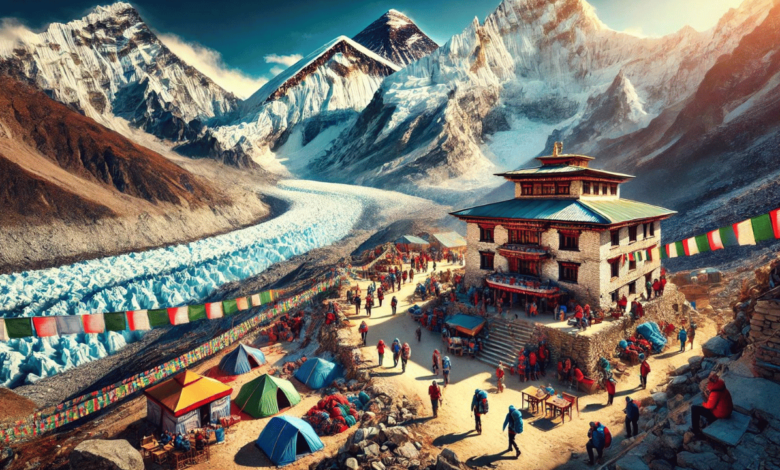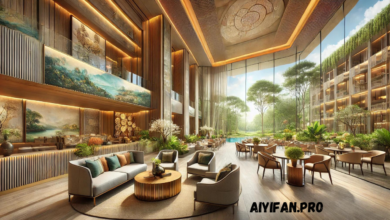Everest Base Camp Trek Must See Attractions Along the Way

The Everest Base Camp trek is renowned for its breathtaking landscapes and cultural richness, offering a series of must-see attractions that make the journey unforgettable. From the moment you set off from Lukla, the adventure is filled with spectacular sights and experiences that capture the essence of the Himalayas.
One of the first highlights is the bustling town of Namche Bazaar, the gateway to the Everest region. Situated at an altitude of 3,440 meters, this vibrant market town serves as an acclimatization stop and offers stunning views of the surrounding peaks. The town is also home to the Sherpa Museum and the National Park Center, which provide insights into the local culture and the natural environment of the Khumbu region.
As the trek continues, the trail leads to Tengboche Monastery, one of the most important spiritual sites in the Everest region. Located at 3,867 meters, this monastery is renowned for its impressive architecture and panoramic views of Everest, Lhotse, and Ama Dablam. The monastery’s serene atmosphere and the opportunity to witness traditional Buddhist ceremonies add a deep cultural dimension to the trek.
Further along the trail, trekkers reach Dingboche, a charming village that sits at 4,410 meters. The village offers incredible views of the surrounding peaks and serves as a crucial acclimatization stop. Nearby, the Nagarjun Hill provides a rewarding hike with panoramic views of the Himalayas, including Everest, Makalu, and Cho Oyu.
Another highlight is the Khumbu Glacier, a massive expanse of ice that trekkers cross on their way to Everest Base Camp. The glacier’s dramatic ice formations and the rugged terrain offer a glimpse into the raw power of nature. The final stretch to Everest Base Camp itself is a moment of triumph. The base camp, situated at 5,364 meters, is a hub of activity during the climbing season, with climbers preparing for their ascent and trekkers marveling at the towering peaks of Everest and its neighboring giants.
The trek also passes through Lobuche and Gorak Shep, both of which offer stunning views of the surrounding mountains and serve as base points for exploring Everest Base Camp and the nearby Kala Patthar. Kala Patthar, at 5,550 meters, is renowned for its spectacular panoramic views of Mount Everest and the surrounding peaks, especially at sunrise.
Each of these attractions contributes to the grandeur of the Everest Base Camp trek, offering a blend of natural beauty, cultural heritage, and personal achievement that makes the journey truly memorable.
Introduction
The Everest Base Camp trek is a journey of a lifetime, offering trekkers an unparalleled experience of the Himalayan region’s natural beauty and cultural richness. This iconic trek takes adventurers through some of the most stunning landscapes on earth, from lush forests and quaint villages to rugged mountains and icy glaciers. Along the way, trekkers encounter significant cultural and historical sites that provide deeper insight into the region’s heritage. Understanding these key attractions can enhance the trekking experience, allowing trekkers to fully appreciate the diverse elements that make the Everest Base Camp trek so extraordinary.
Overview of the Trek
The Everest Base Camp trek is a challenging yet rewarding adventure that spans approximately 12 to 16 days. The trek begins with a flight from Kathmandu to Lukla, a small town perched high in the Himalayas, and continues through the Khumbu Valley. The journey involves traversing through picturesque Sherpa villages, dense forests, and rocky terrains, with several acclimatization stops to help trekkers adjust to the altitude. Key stops include Namche Bazaar, Tengboche, Dingboche, and Lobuche, each offering unique experiences and breathtaking views. The trek culminates at Everest Base Camp, where trekkers can enjoy the close-up views of Mount Everest and the surrounding peaks. Along the route, trekkers are treated to a mix of natural beauty and cultural encounters, making the journey a comprehensive exploration of the Everest region.
Lukla: Gateway to Everest
Lukla is the starting point for the Everest Base Camp Trek Altitude Training and serves as the gateway to the Khumbu region. Located at an altitude of 2,860 meters, this small town is accessible only by a short, thrilling flight from Kathmandu. The name “Lukla” means “Place with Lots of Sheep,” reflecting its pastoral past. The town is known for its airport, Tenzing-Hillary Airport, which is one of the world’s most dangerous airstrips due to its short runway and challenging weather conditions. Despite its small size, Lukla is a bustling hub with numerous teahouses, shops, and trekking agencies. It provides trekkers with essential supplies and serves as the initial acclimatization point. The dramatic landscape of Lukla, with its stunning mountain views and vibrant local culture, sets the tone for the adventure ahead.
Namche Bazaar: The Sherpa Capital
Namche Bazaar, located at an altitude of 3,440 meters, is often referred to as the “Sherpa Capital” of the Everest region. This vibrant town is a crucial stop for trekkers due to its role as an acclimatization point and its strategic location in the Khumbu Valley. Namche Bazaar is a bustling market town with a mix of traditional Sherpa culture and modern amenities. The town features a variety of shops, lodges, and eateries, providing trekkers with opportunities to purchase supplies, exchange currency, and enjoy local cuisine. Namche Bazaar is also known for its stunning views of the surrounding peaks, including Everest and Lhotse. Key attractions include the Sherpa Museum and the Everest View Hotel, which offer insights into local culture and breathtaking panoramic views. The town’s vibrant atmosphere and its role as a cultural and logistical hub make it a significant highlight of the trek.
Tengboche Monastery: Spiritual Center
Tengboche Monastery, located at an altitude of 3,867 meters, is one of the most important and revered spiritual sites in the Everest region. The monastery is renowned for its impressive architecture, including its red-and-white facade and traditional Tibetan design. It is a focal point for Buddhist practices and ceremonies, making it a significant cultural landmark along the trek. The monastery is situated on a ridge that provides spectacular views of Mount Everest, Lhotse, and Ama Dablam, enhancing its spiritual ambiance. Trekkers often visit Tengboche Monastery to participate in or observe traditional Buddhist rituals, including prayer ceremonies and chanting. The serene environment and the opportunity to engage with local monks offer trekkers a unique glimpse into Sherpa spirituality and cultural traditions. Tengboche Monastery stands as a symbol of the deep spiritual connection that defines the Everest Base Camp trek.
Dingboche: Gateway to the High Himalayas
Dingboche, situated at an altitude of 4,410 meters, serves as a crucial acclimatization stop on the Everest Base Camp trek. This charming village is nestled in a valley surrounded by high mountains, offering trekkers stunning views and a serene environment to adjust to the increasing altitude. Dingboche is characterized by its traditional stone houses, fields of barley, and prayer flags fluttering in the wind, contributing to its picturesque and tranquil atmosphere. It is also an essential stop for acclimatization, allowing trekkers to rest and prepare for the higher altitudes ahead. Nearby, the Nagarjun Hill hike provides an excellent opportunity for acclimatization while offering panoramic views of some of the region’s most majestic peaks, including Makalu, Lhotse, and Everest. Dingboche’s role as the gateway to the high Himalayas is underscored by its position along the trail, its significance in acclimatization, and its stunning natural beauty.
Lobuche: Scenic Views of the Khumbu Glacier
Lobuche, located at 4,940 meters, is a key stop on the Everest Base Camp Trek for Beginners offering trekkers breathtaking views of the Khumbu Glacier. This village is a crucial staging point before the final push to Everest Base Camp. The landscape around Lobuche is defined by rugged terrain and the impressive Khumbu Glacier, which trekkers cross on their way to base camp. The glacier’s icy surface and dramatic crevasses highlight the raw power of the region’s glacial systems. From Lobuche, trekkers can enjoy spectacular views of nearby peaks, including Nuptse and Pumori, which add to the village’s allure. The trek from Lobuche to Everest Base Camp involves traversing the glacier’s rugged terrain, making Lobuche an important waypoint and a scenic highlight before reaching the ultimate destination. The stunning views and challenging terrain make Lobuche a memorable part of the Everest Base Camp journey.
Gorak Shep: Last Stop Before Base Camp
Gorak Shep, located at an altitude of 5,164 meters, is the final stop before reaching Everest Base Camp. This small settlement is situated on a moraine of the Khumbu Glacier and offers a few basic lodges for trekkers to rest and acclimate before the final ascent. Gorak Shep provides trekkers with a crucial opportunity to recharge and prepare for the journey to Everest Base Camp, which is just a few hours away. The village offers limited facilities but has an incredible location that provides stunning views of the surrounding mountains. From Gorak Shep, trekkers can make the final push to Everest Base Camp, which involves navigating the rugged terrain of the Khumbu Glacier. Gorak Shep’s role as the last stop before base camp adds to its significance as a critical point on the trek, where the anticipation and excitement for the ultimate destination build to a crescendo.
Everest Base Camp: The Ultimate Destination
Everest Base Camp, situated at 5,364 meters, is the ultimate destination for trekkers on this iconic journey. This legendary base camp, positioned at the foot of Mount Everest, offers a once-in-a-lifetime opportunity to stand in the shadow of the world’s highest peak. The camp itself is a bustling hub of activity, especially during the climbing season, with mountaineers preparing for their ascent and trekkers marveling at the awe-inspiring surroundings. The views from base camp are nothing short of spectacular, with the massive icefall and towering peaks creating a dramatic backdrop. The sense of accomplishment and the breathtaking scenery make Everest Base Camp a memorable highlight of the trek, symbolizing the culmination of a challenging journey and providing a profound connection to the world’s highest mountain.
Kala Patthar: Panoramic Views of Everest
Kala Patthar, located at 5,550 meters, is renowned for offering some of the best panoramic views of Mount Everest and the surrounding peaks. This prominent viewpoint, situated on a ridge just above Gorak Shep, provides trekkers with a stunning vantage point to take in the grandeur of Everest and its neighboring giants, including Lhotse, Nuptse, and Makalu. The ascent to Kala Patthar is a challenging yet rewarding climb that typically occurs early in the morning to catch the sunrise over Everest. The sweeping vistas from the summit are truly breathtaking, making Kala Patthar a highlight of the Everest Base Camp trek. The opportunity to witness the first light of dawn illuminating Everest and the surrounding peaks offers trekkers a memorable and dramatic conclusion to their adventure, capturing the essence of the Himalayas in a single, panoramic view.
Khumbu Glacier: A Natural Wonder
The Khumbu Glacier, a vast and impressive ice formation, is one of the most striking features along the Everest Base Camp Trek Cultural Highlights. Stretching from the southern slopes of Mount Everest, the glacier flows through the Khumbu Valley and provides a dramatic backdrop to the trek. Trekkers encounter the glacier as they make their way from Lobuche to Everest Base Camp, navigating its rugged terrain and crevasses. The glacier’s surface is a dynamic landscape of icefalls, seracs, and crevasses, showcasing the immense scale and power of nature. The icy expanse, coupled with the surrounding peaks, creates a surreal and breathtaking environment. As trekkers traverse this icy wonderland, they gain a profound appreciation for the sheer magnitude and beauty of the Himalayas. The Khumbu Glacier is not only a critical part of the trek but also a highlight that leaves a lasting impression on those who experience its grandeur.
Pheriche: Stunning Landscapes
Pheriche, located at 4,371 meters, is a small village in the Khumbu region known for its stunning landscapes and role as a vital acclimatization stop. Nestled in a picturesque valley, Pheriche offers trekkers panoramic views of the surrounding peaks, including Ama Dablam and the Cholatse. The village is characterized by its traditional stone houses and open fields, providing a serene and scenic environment. The nearby Pheriche Viewpoint offers a rewarding hike with expansive views of the valley and the surrounding mountains. The clear, crisp air and the dramatic scenery make Pheriche a memorable part of the Everest Base Camp trek. Its role in the acclimatization process, combined with its breathtaking landscapes, ensures that trekkers are well-prepared for the higher altitudes and challenges ahead.
The Sagarmatha National Park
Sagarmatha National Park, a UNESCO World Heritage Site, encompasses the Everest region and is renowned for its spectacular natural beauty and biodiversity. The park, established in 1976, covers an area of approximately 1,148 square kilometers and includes the highest peaks in the world, including Mount Everest. The park is home to a diverse range of flora and fauna, including rare species such as the snow leopard and red panda. Trekking through Sagarmatha National Park, trekkers are treated to a variety of ecosystems, from lush forests and alpine meadows to barren, high-altitude landscapes. The park’s protected status helps preserve its unique environment and cultural heritage, providing a pristine backdrop for the Everest Base Camp trek. Exploring the park’s diverse landscapes and observing its wildlife enhance the trekking experience, making it an integral part of the journey.
Local Villages and Cultural Experiences
The Everest Base Camp trek offers rich cultural experiences through the local Sherpa villages encountered along the way. These villages, such as Namche Bazaar, Dingboche, and Pheriche, are hubs of Sherpa culture and provide trekkers with insights into traditional mountain life. The villages feature traditional stone houses, vibrant prayer flags, and bustling markets, reflecting the unique cultural heritage of the region. Visitors have the opportunity to engage with local communities, sample traditional Sherpa cuisine, and visit cultural landmarks such as monasteries and stupas. Interaction with local people and participation in cultural ceremonies offer a deeper understanding of the Sherpa way of life and add a meaningful dimension to the trek. The blend of stunning natural landscapes and rich cultural experiences makes the Everest Base Camp trek a journey that is as culturally enriching as it is physically rewarding.
Conclusion: Making the Most of Your Trek
To truly make the most of your Everest Base Camp trek, it is essential to embrace both the natural wonders and the cultural experiences along the route. From the majestic Khumbu Glacier and the breathtaking views from Kala Patthar to the serene landscapes of Pheriche and the cultural richness of local villages, each aspect of the trek contributes to its unique allure. Proper preparation, including acclimatization and gear management, ensures a safe and enjoyable journey. Engaging with local communities and appreciating the diverse landscapes enhance the trekking experience, creating lasting memories of one of the world’s most iconic adventures. By immersing yourself in the beauty and culture of the Everest region, you ensure a trek that is not only a physical challenge but also a profound and enriching experience.




